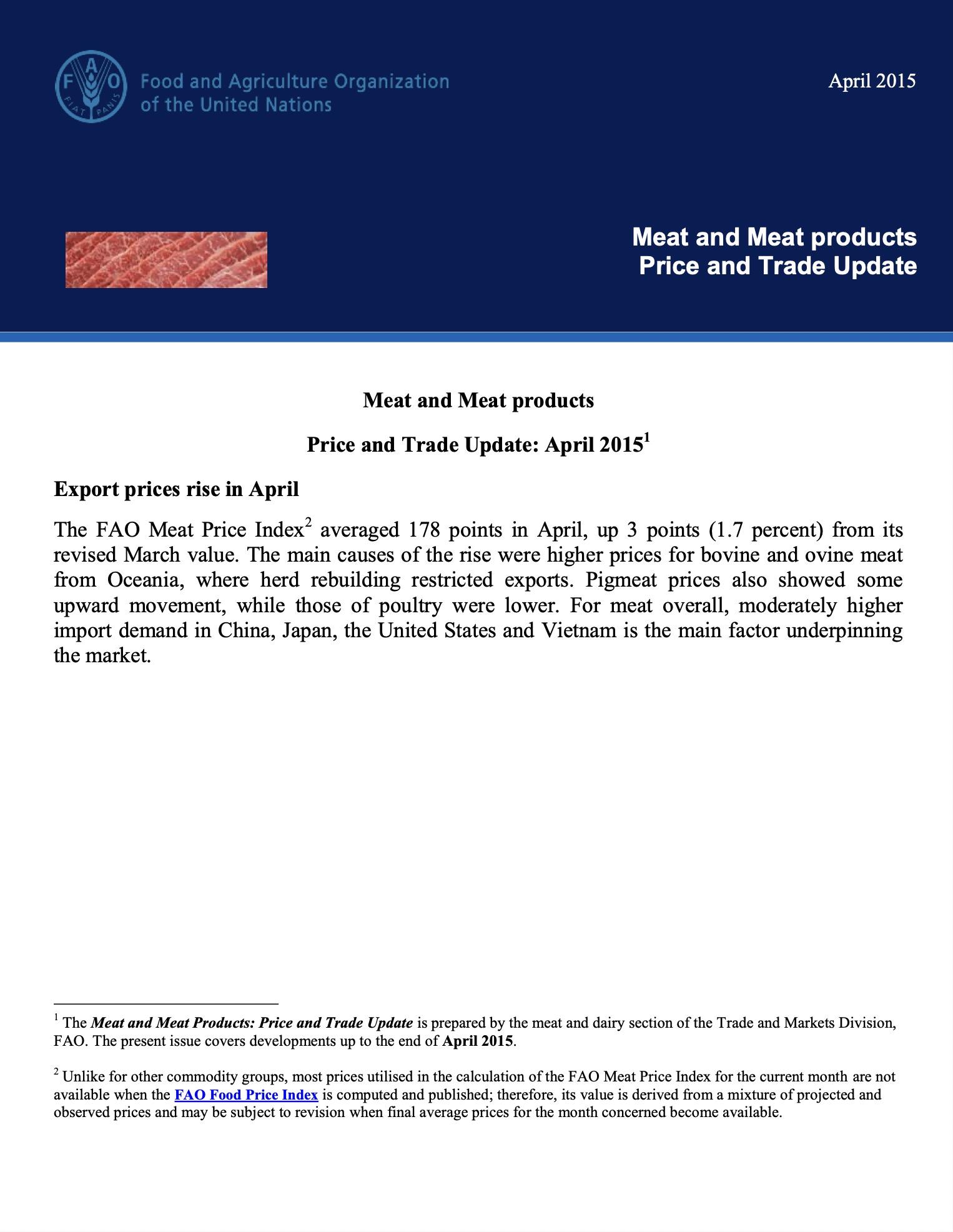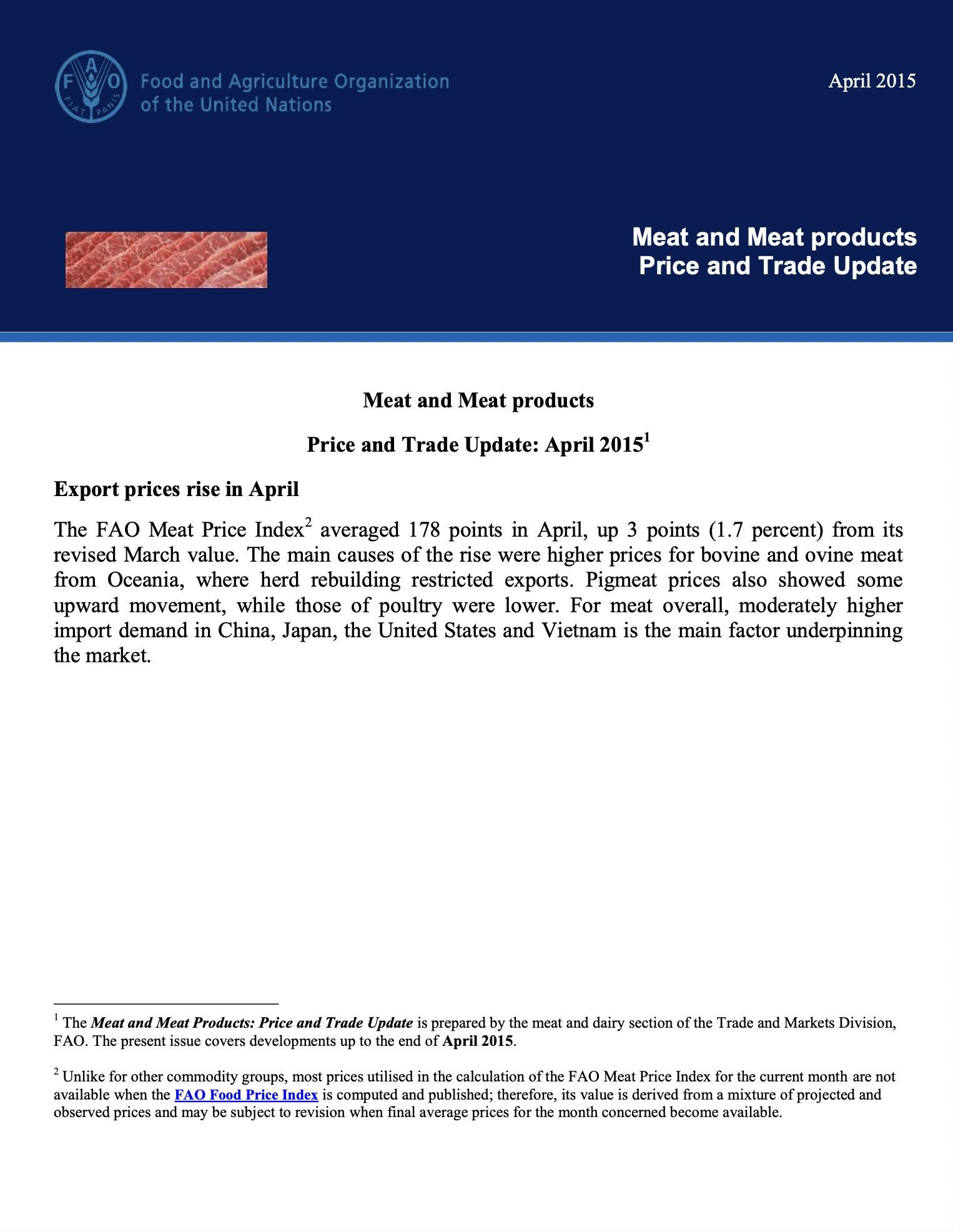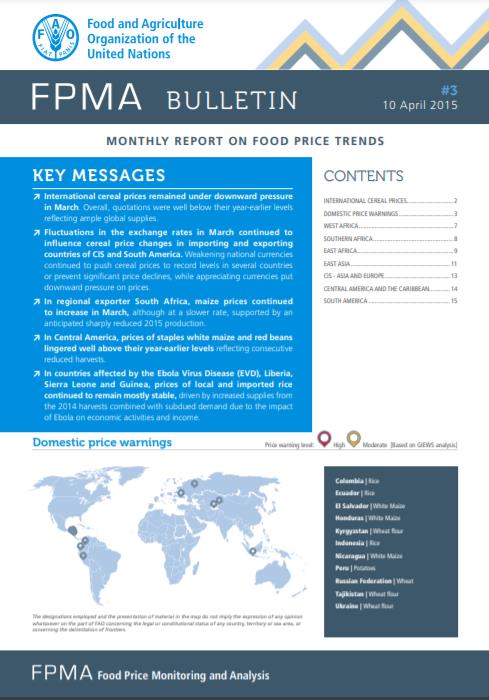
Food Price Monitoring and Analysis (FPMA) Bulletin #3, 10 April 2015
10/04/2015
International cereal prices remained under downward pressure in March. Overall, quotations were well below their year-earlier levels reflecting ample global supplies. Fluctuations in the exchange rates in March continued to influence cereal price changes in importing and exporting countries of CIS and South America. Weakening national currencies continued to push cereal prices to record levels in several countries or prevent significant price declines, while appreciating currencies put downward pressure on prices. In regional exporter South Africa, maize prices continued to increase in March, although at a slower rate, supported by an anticipated sharply reduced 2015 production. In Central America, prices of staples white maize and red beans lingered well above their year-earlier levels reflecting consecutive reduced harvests. In countries affected by the Ebola Virus Disease (EVD), Liberia, Sierra Leone and Guinea, prices of local and imported rice continued to remain mostly stable, driven by increased supplies from the 2014 harvests combined with subdued demand due to the impact of Ebola on economic activities and income.
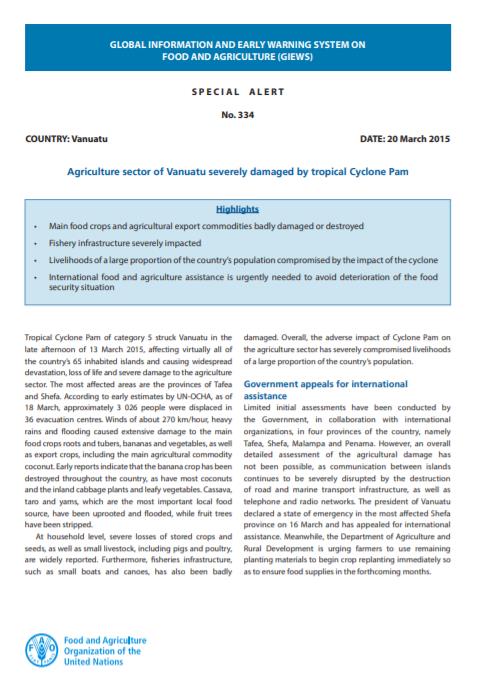
GIEWS Special Alert No. 334 - Vanuatu, 20 March 2015
20/03/2015
Main food crops and agricultural export commodities badly damaged or destroyed. Fishery infrastructure severely impacted. Livelihoods of a large proportion of the country’s population compromised by the impact of the cyclone. International food and agriculture assistance is urgently needed to avoid deterioration of the food security situation.
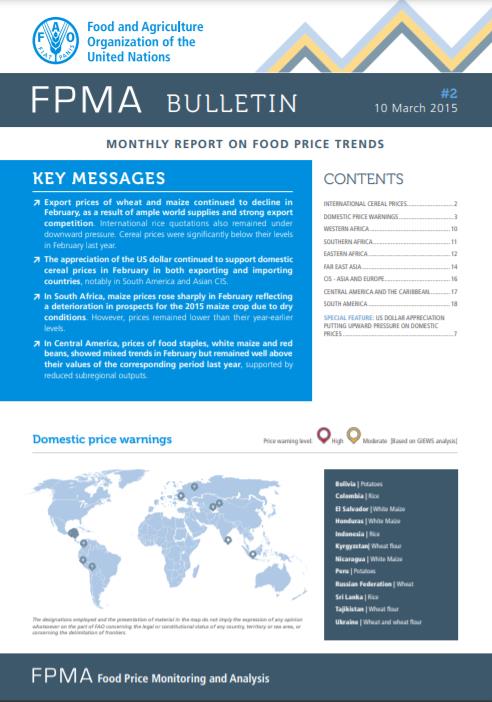
Food Price Monitoring and Analysis (FPMA) Bulletin #2, 10 March 2015
10/03/2015
Export prices of wheat and maize continued to decline in February, as a result of ample world supplies and strong export competition. International rice quotations also remained under downward pressure. Cereal prices were significantly below their levels in February last year. The appreciation of the US dollar continued to support domestic cereal prices in February in both exporting and importing countries, notably in South America and Asian CIS. In South Africa, maize prices rose sharply in February reflecting a deterioration in prospects for the 2015 maize crop due to dry conditions. However, prices remained lower than their year‑earlier levels. In Central America, prices of food staples, white maize and red beans, showed mixed trends in February but remained well above their values of the corresponding period last year, supported by reduced subregional outputs.
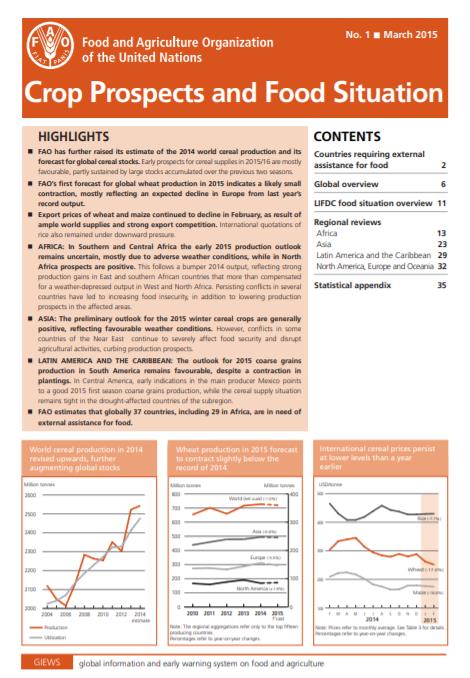
Crop Prospects and Food Situation #1, March 2015
05/03/2015
Crop Prospects and Food Situation is published by the Trade and Markets Division of FAO under the Global Information and Early Warning System (GIEWS). It is published four times a year and focuses on developments affecting the food situation of developing countries and the Low-Income Food-Deficit Countries (LIFDCs) in particular. The report provides a review of the food situation by geographic region, a section dedicated to the LIFDCs and a list of countries requiring external assistance for foo d. It also includes a global cereal supply and demand overview to complement the biannual analysis in the Food Outlook publication. Crop Prospects and Food Situation is available in English, French and Spanish in electronic format.
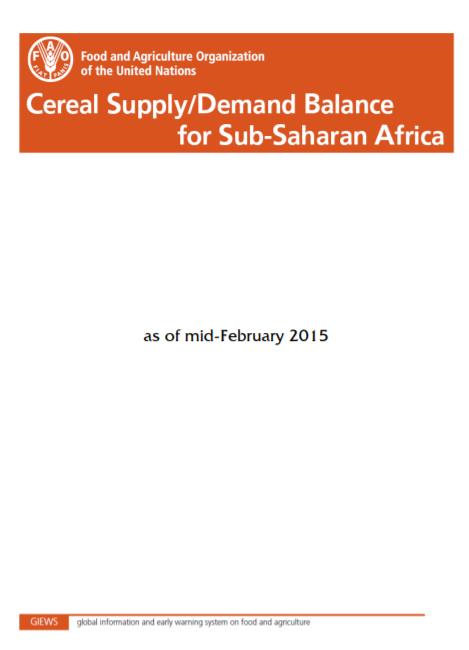
Cereal supply and demand balances for sub-Saharan African countries - No.1, February 2015
19/02/2015
The FAO/GIEWS Country Cereal Balance System (CCBS) is a database of annual supply and utilization balances for main cereals, covering all countries of the world. It has been maintained by FAO/GIEWS since 1980 and is updated on a continual basis. This statistical report, which is a subset of CCBS data, presents the current-year cereal supply and demand balances for all sub-Saharan African countries, highlighting cereal import and food aid requirements of each country. This report is complement ary to the FAO/GIEWS report Crop Prospects and Food Situation and is published four times a year, with the same schedule.
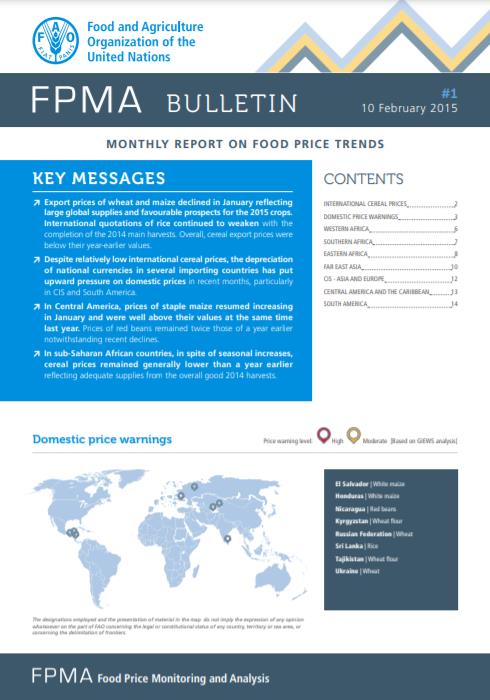
Food Price Monitoring and Analysis (FPMA) Bulletin #1, 10 February 2015
10/02/2015
Export prices of wheat and maize declined in January reflecting large global supplies and favourable prospects for the 2015 crops. International quotations of rice continued to weaken with the completion of the 2014 main harvests. Overall, cereal export prices were below their year-earlier values.
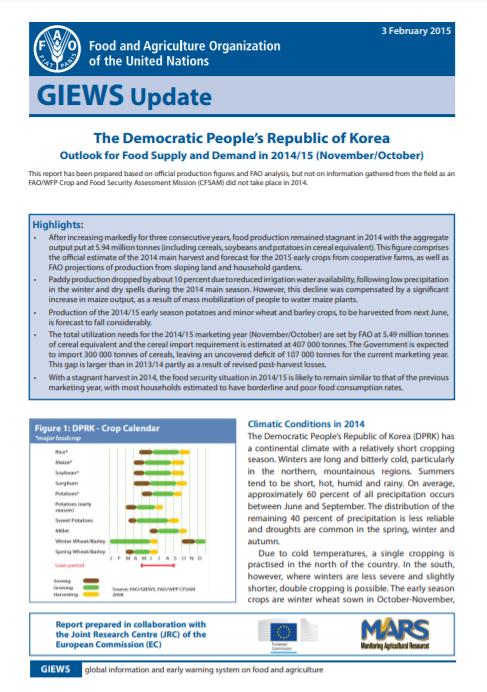
GIEWS Update - The Democratic People’s Republic of Korea, 3 February 2015
03/02/2015
After increasing markedly for three consecutive years, food production remained stagnant in 2014 with the aggregate output put at 5.94 million tonnes (including cereals, soybeans and potatoes in cereal equivalent). This figure comprises the official estimate of the 2014 main harvest and forecast for the 2015 early crops from cooperative farms, as well as FAO projections of production from sloping land and household gardens.
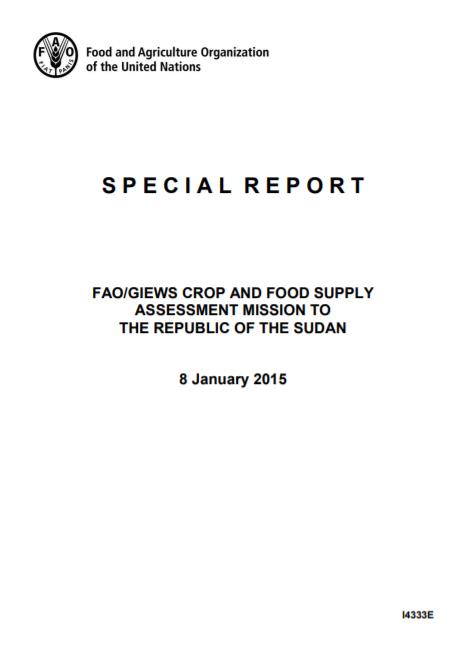
Special Report - FAO/GIEWS Crop and Food Supply Assessment Mission to the Republic of the Sudan
08/01/2015
GIEWS Special Reports and Alerts - These short reports describe the food supply and agricultural situation in countries or sub-regions experiencing particular food supply difficulties. They also alert the international community on measures to be taken. Special Reports are often the result of rapid evaluation missions - or Crop and Food Security Assessment Missions (CFSAMs). We include below two reference documents on the CFSAM methodology.
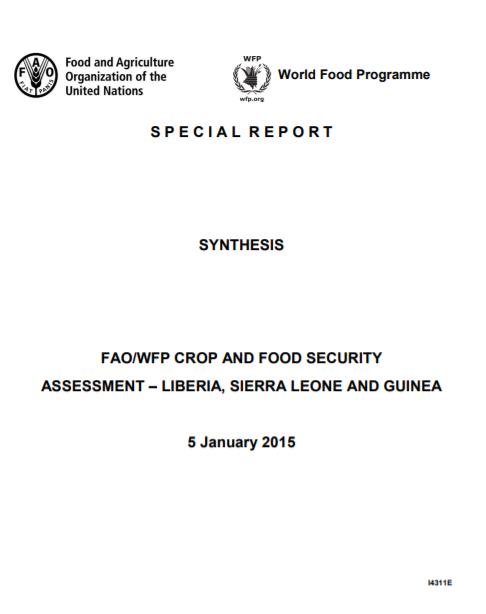
Special Report - Synthesis FAO/WFP Crop and Food Security Assessment - Liberia, Sierra Leone and Guinea
05/01/2015
Rice production is estimated to decline by 12 percent, 8 percent and 3.7 percent in Liberia, Sierra Leone and Guinea, respectively. The sub-national level impact on production is much higher (up to 20 percent) in the areas hit hardest by the disease. The general decline in economic activity has severely affected households’ wages and incomes. The number of food insecure individuals due to Ebola is estimated in hundreds of thousands in each country and is expected to rise in 2015. The loss of livelihoods coupled with market uncertainties call for flexibility and care in the type and scale of interventions mainly in food and agriculture assistance.
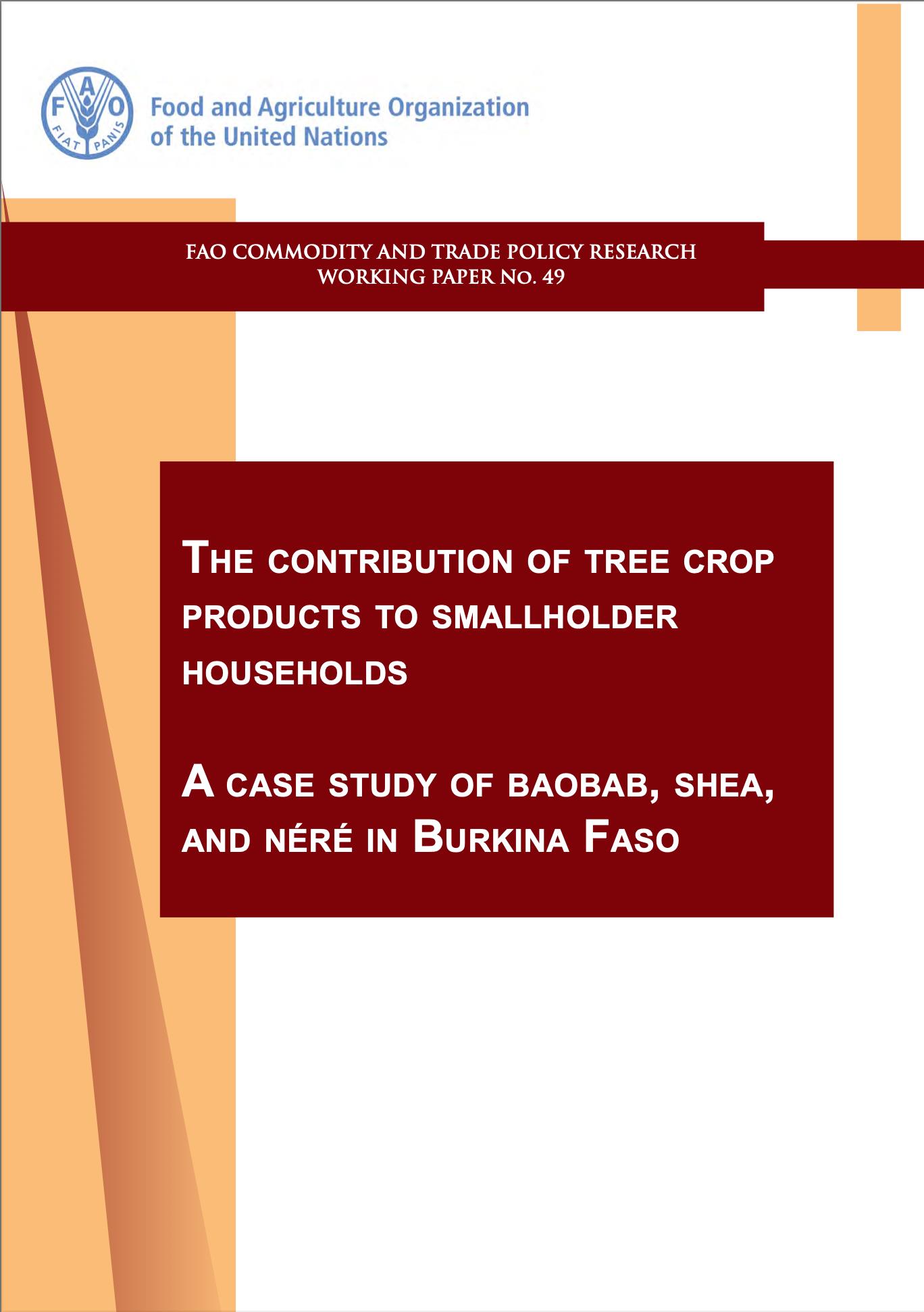
The Contribution of Tree Crop Products to Smallholder Households: A case study of Baobab, Shea, and Néré in Burkina Faso
01/01/2015
This document examines the contrib ution of tree products derived from baobab (Adansonia digitata), shea (Vitellaria paradoxa) and néré (Parkia biglobosa) to smallholder livelihoods where these nontimber forest products form a significant part of the subsistence economies of smallholder households in the Sahelian region. The benefits are access to nutritious foodstuffs particularly during the soudure hunger season and are also commercialised.
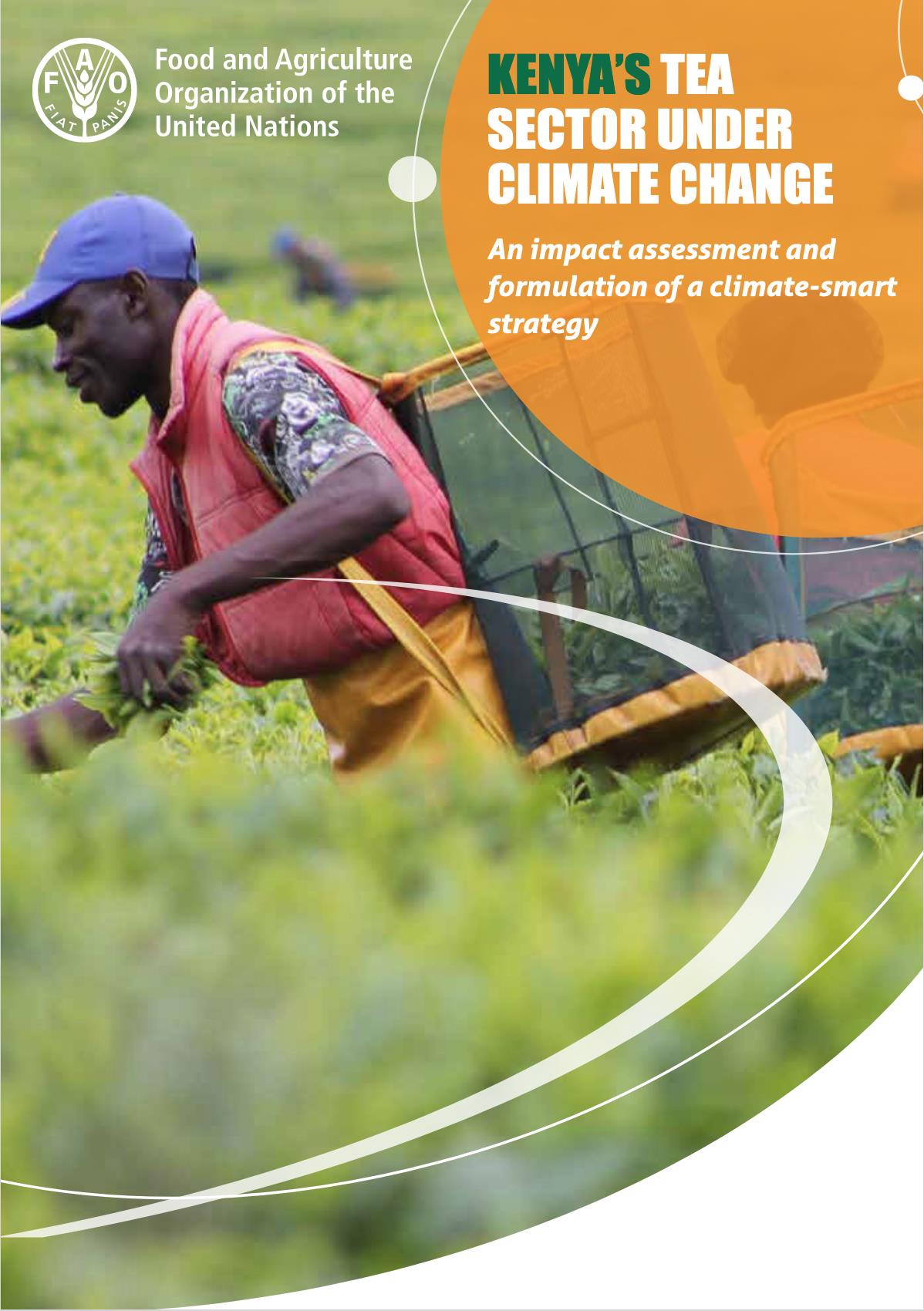
Kenya's Tea Sector under Climate Change
01/01/2015
Following the Intergovernmental Group Meeting on Tea in New Delhi in 2010, FAO was requested by the Government of Kenya to assist with a climate change impact assessment of tea in Kenya and to help develop a new strategy to confront its effects. This report is the outcome of a two-year project in Kenya and offers the findings from an integrated climate impact assessment. The analysis covered (i) historical and future links between climate parameters and tea yields, (ii) a carbon life cycle analy sis, (iii) tea management scenarios under climate change using aquacrop model, and (iv) a socio-economic analysis of small holder tea farms and households and their coping options under climate change. The report also summarizes the core elements of an inclusive, multi-stakeholder-led new climate-compatible strategy for tea.
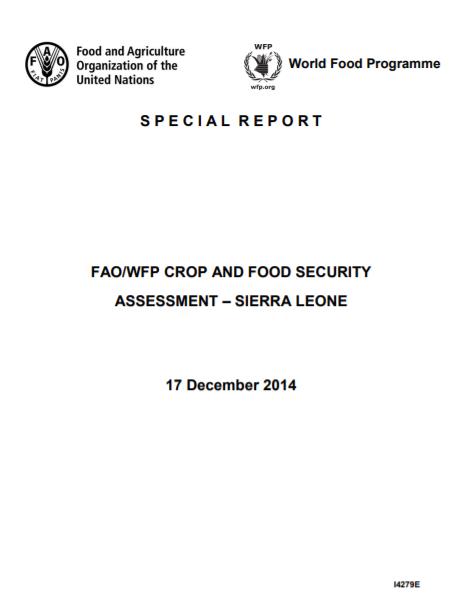
Special Report - FAO/WFP Crop and Food Security Assessment - Sierra Leone
17/12/2014
The Ebola Virus Disease (EVD) outbreak resulted in a serious shock to the agriculture and food sectors in 2014. The epidemic started spreading when crops were being planted and expanded during the crop maintenance and the critical harvesting period for the staple crops rice, maize and cassava. Nationally, the aggregate food crop production is estimated at about 2.09 million tonnes, about five percent lower than 2013. Milled rice production, accounting for about 85 percent of the cereal productio n, is estimated at 770 000 tonnes, about 8 percent below last year. However, the modest decline at the national level masks the significant harvest declines at sub-national levels of up to 17 percent. Cereal import requirements in 2015 are therefore estimated at 300 000 tonnes, slightly up from last year. Rice import requirements account for about 215 000 tonnes of the total. With commercial imports estimated at 285 000 tonnes the uncovered gap is estimated at about 55 000 tonnes for which addit ional resources and international assistance is required. The significant impact of Ebola on export earnings is expected to have compromised the country’s ability to import more. Border closures, quarantine measures and other restrictions have seriously disrupted marketing of goods including agricultural commodities. Trade activities have declined significantly, particularly in quarantined districts. About 450 000 people, or 7.5 percent of the population, are estimated to be severely food insecu re as of December 2014. The impact of EVD accounts for more than a quarter of the food insecure. The number of food insecure is projected to increase to 610 000 by March 2015, 280 000 of which are attributed to EVD. About 76 percent of the Ebola related food insecure individuals live in rural areas. The most food insecure households include food crop producers; fishermen and hunters; and unskilled labourers. The analysis indicates that different type of food assistance will be required. In addit ion to covering the import gap, cash/voucher transfers where appropriate can assure food access for people whose main livelihood is not agriculture. Given reductions in trader activity, local purchase in surplus areas can assure that surpluses are being redistributed. Frequent food security monitoring activities must continue as the situation is highly fragile and could further flare up at any time. The loss of livelihoods coupled with this market uncertainties means that there is a need for fle xibility both in the type and scale of intervention that will be needed in 2015.
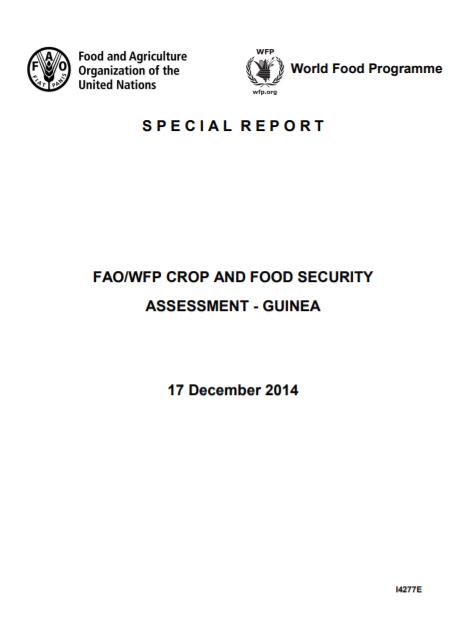
Special Report - FAO/WFP Crop and Food Security Assessment - Guinea
17/12/2014
FAO and WFP, in collaboration with the Government and partners have been actively carrying out field level rapid assessments to assess the impact of the EVD crisis on food production, supply situation and the overall food security primarily through rapid assessment. In addition, FAO/GIEWS has developed a Disease Impact on Agriculture – Simulation (DIAS) Model to provide estimates of the impact of EVD on crop production, while WFP has developed a framework to estimate the current and future number of food insecure people due to EVD and a light version of a shock impact simulation model (SISMod-Light). The main objective of this report is to provide the synthesis of the results based on the models and the rapid assessments and other relevant sources of information on 2014 food production, and the analysis of market dynamics and household food security for the coming marketing year 2015.
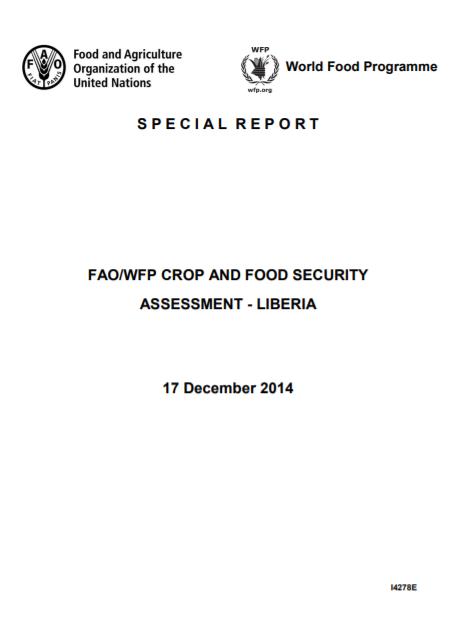
Special Report - FAO/WFP Crop and Food Security Assessment - Liberia
17/12/2014
FAO and WFP, in collaboration with the Government and other partners have been actively carrying out field level rapid assessments to assess the impact of the EVD crisis on food production, supply situation and the overall food security primarily through rapid assessment. In addition, FAO/GIEWS has developed a Disease Impact on Agriculture – Simulation (DIAS) Model to provide estimates of the impact of EVD on crop production, while WFP has developed a framework to estimate the current and future number of food insecure people due to EVD and a light version of a shock impact simulation model (SISMod-Light). The main objective of the this report is to provide the synthesis of the results based on the models and the rapid assessments and other relevant sources of information on 2014 food production, and the analysis of market dynamics and household food security for the coming marketing year 2015.

No. 14 Consideration in the reform of agricultural trade policy in low income developing countries
12/12/2014
Many developing countries are currently under pressure to reduce their trade barriers to the entry of agricultural products. This pressure comes both as a result of ongoing trade negotiations (multilateral, plurilateral or bilateral) and due to policy advice from donors and international organizations based on the assumption that a liberal agricultural trade policy is necessary to allow growth through trade expansion.
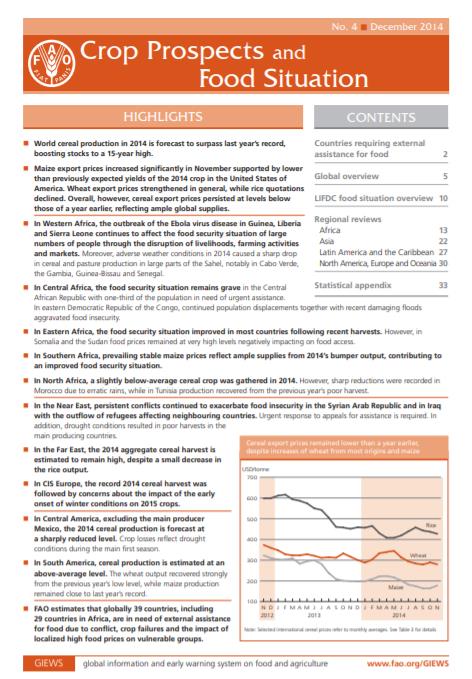
Crop Prospects and Food Situation #4, December 2014
11/12/2014
GIEWS, the Global Information and Early Warning System on Food and Agriculture continuously monitors crop prospects and food security situation at global, regional, national and sub-national levels and warns of impending food difficulties and emergencies. Established in the wake of the world food crisis of the early 1970’s, GIEWS maintains a unique database on all aspects of food supply and demand for every country of the world. The System regularly provides policy makers and the international c ommunity with up-to-date information so that timely interventions can be planned and suffering avoided. The report provides a review of the food situation by geographic region, a section dedicated to the LIFDCs and a list of countries requiring external assistance for food. It also includes a global cereal supply and demand overview to complement the biannual analysis in the Food Outlook publication.
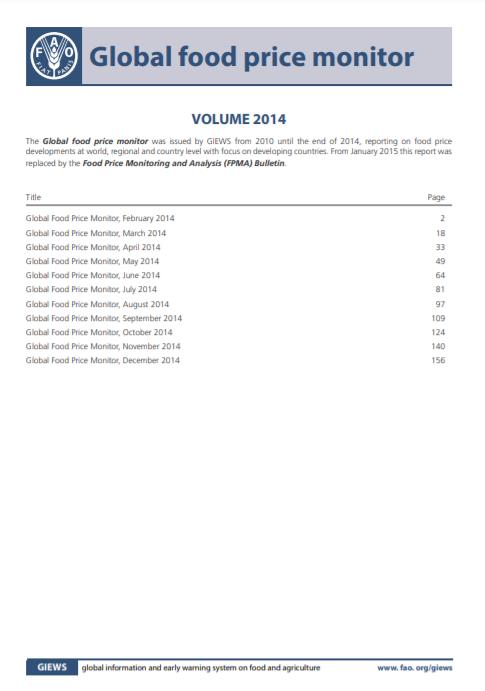
Global food price monitor - Volume 2014
11/12/2014
The Global food price monitor was issued by GIEWS from 2010 until the end of 2014, reporting on food price developments at world, regional and country level with focus on developing countries. From January 2015 this report was replaced by the Food Price Monitoring and Analysis (FPMA) Bulletin.
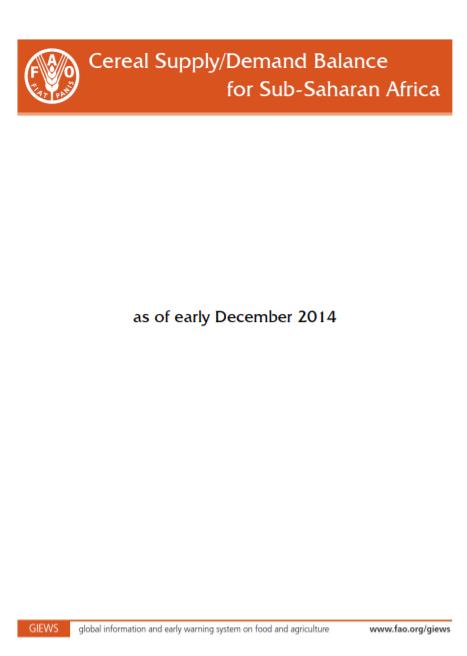
Cereal supply and demand balances for sub-Saharan African countries - No.4, December 2014
04/12/2014
The FAO/GIEWS Country Cereal Balance System (CCBS) is a database of annual supply and utilization balances for main cereals, covering all countries of the world. It has been maintained by FAO/GIEWS since 1980 and is updated on a continual basis. This statistical report, which is a subset of CCBS data, presents the current-year cereal supply and demand balances for all sub-Saharan African countries, highlighting cereal import and food aid requirements of each country. This report is complement ary to the FAO/GIEWS report Crop Prospects and Food Situation and is published four times a year, with the same schedule.

